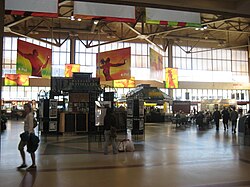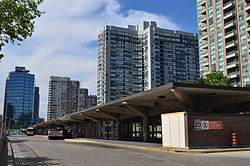Transport hub
A transport hub (also transport interchange) is a place where passengers and cargo are exchanged between transport modes. Public transport hubs include train stations, rapid transit stations, bus stops, tram stop, airports and ferry slips. Freight hubs include classification yards, seaports and truck terminals, or combinations of these. For private transport, the parking lot functions as a hub.
Delta Air Lines first used the hub and spoke system for aviation in 1955 from its hub in Atlanta, Georgia, United States.[1] This was to compete with Eastern Air Lines. FedEx adopted the hub and spoke model for overnight package delivery during the 1970s. When the airline industry was deregulated in 1978, Delta's hub and spoke system was used by several airlines.[2]
Transport Hub Media
Penn Station in Midtown Manhattan, New York City, the busiest transportation hub in the Western Hemisphere
Underground bus and coach terminal and metro station are located underneath the Kamppi Center in Helsinki, Finland
Szczecin: Port of Szczecin, motorway, expressway and railway connections, an inter-city public transport, a city bus and electric trams network and "Solidarity" Szczecin–Goleniów Airport, Poland
South Station, an MBTA, Amtrak, and Greyhound transportation hub in Boston, Massachusetts, United States
DHL hub Leipzig/Halle Airport, Germany
In suburban Toronto, Finch Station connects underground train, local, regional, and interregional bus services.
References
- ↑ Delta Air Lines. "Delta through decades".
- ↑ Robert M. Kane, Air Transportation (Dubuque, IA: Kendall Hunt Publishing , 2003), p. 138





